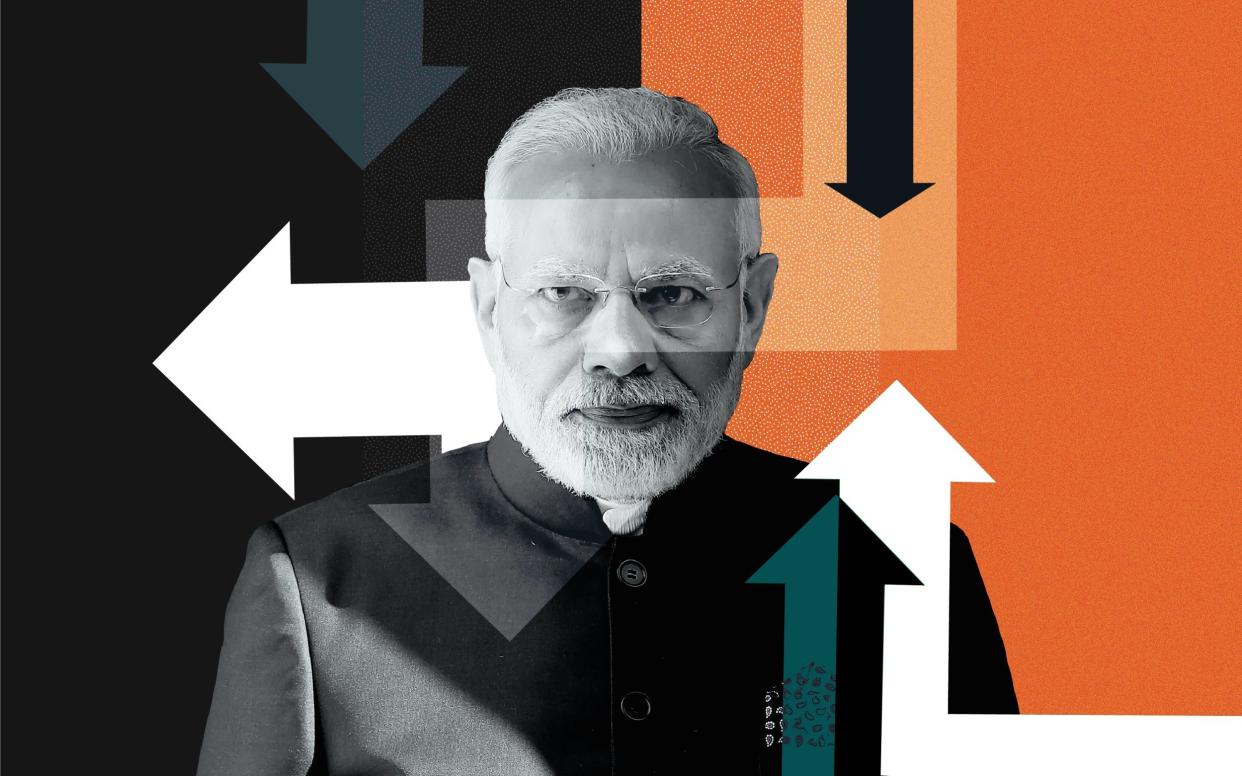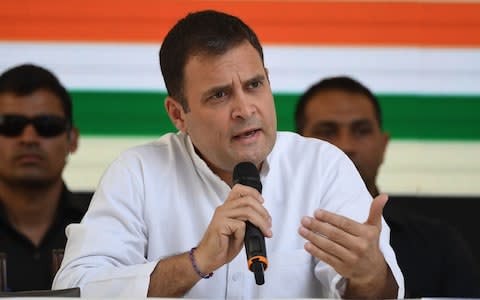Why Narendra Modi is no longer certain to win India's mega-election

Narendra Modi, after India’s 2014 General Election vowed, “Good days are coming”. His Bharatiya Janata Party (BJP) had secured a landslide victory, forming the largest majority government since 1984.
Analysts had lauded Mr Modi’s ambitious ‘Development For All’ manifesto.
Throughout a gruelling campaign, which saw the then 64-year-old address over 450 rallies, he promised to transform living standards for every Indian from subsistence farmers in rural Nagaland to technology entrepreneurs in urban Pune.
However, fast forward to 2018 and the BJP suffered regional election defeats in Madhya Pradesh, Rajasthan and Chhattisgarh – each time to resurgent opposition, the Indian National Congress (INC).
These three ‘Hindu heartland’ provinces are considered good signifiers of how the whole country will vote in this week’s General Election.
Heading into the vote, Mr Modi’s popularity is at an all-time low.
An India Today poll on January 9 found support for the Prime Minister had plummeted from 65% to 46% since January 2017.
So, why has Mr Modi’s re-election gone from inevitable to uncertain?
Economy
During his 2014 Indian tour de force, Mr Modi made several high-profile economic pledges.
Infamously, he promised to create ten million new jobs every year if elected.
In reality, Mr Modi generated just 5.8 million roles annually and unemployment in India currently stands at a 45-year high.
Ensuring India’s economy grows at the same meteoric rate as its population will be one of the defining issues for the next Prime Minister.
Mr Modi’s failure to create new employment has hurt his popularity across society.
One-third of the unemployed are ‘highly educated’ young people whilst the mismanagement of the agricultural sector – on which 55 per cent of Indians depend for income – has seen many Indians fall further into poverty.
A 2017 Gallup poll discovered only 3 per cent of its population described themselves as economically ‘thriving’, compared to 14 per cent in 2014.
Mr Modi’s most newsworthy economic policy pledge however was his ‘great Indian demonetisation’. In November 2016, he decided to cancel all 500 (£5.50) and 1,000 (£11) rupee notes in circulation.
An incredible 86 per cent of all cash in India suddenly became worthless.
By introducing a new 500 rupee note and an inaugural 2,000 (£22) rupee note Mr Modi believed he would eradicate black market money, counterfeit notes and halt the financing of terror groups.
However, the plan failed on three counts. Firstly, some Indian banks quickly ran out of the new currency.
An estimated 150 million people didn’t receive their wages for weeks as a result, while the opposition claimed over 100 people died while waiting in bank queues or from stress-induced suicide.
Secondly, transactions in key Indian sectors such as agriculture are entirely dependent on cash.
The shortage of the new, legal banknotes meant farmers could not source cash to purchase seeds or fertilisers, leading to a countrywide drop in crop prices.
Finally – and embarrassingly for Mr Modi – data released by the Reserve Bank of India found that 99 per cent of the old ‘corrupt’ money has been absorbed into the new system.
As a direct result of Mr Modi’s unsuccessful economic policy, many Indians are seeking out an alternative political party to provide the answer to their problems.
The INC, for example, has promised to implement a nationwide means-tested universal basic income system if it wins the election.
This utopian idea is attracting a lot of attention and apparently winning favour with voters.
Nationalism
In order to woo back the electorate, following the huge economic setbacks and rise in popularity of the INC, Mr Modi has embraced populist Hindu nationalism – the belief India is a Holy land purely for Hindus.
However, as India’s constitution vows to treat its residents equally irrespective of religion, Mr Modi is conscious of not wanting to alienate the country’s 172 million Muslim voters and has been accused of not going far enough by some Hindus.
In particular, he has been criticized for delaying a temple construction at Ayodhya – the site of a demolished 16th Century mosque.
Mr Modi’s actions have led some Hindu nationalists to consider supporting the INC’s 25-year-old firebrand, Hardik Patel while many Muslims feel disillusioned that Mr Modi is not safeguarding their rights.
Groups of Hindu nationalists are increasingly carrying out attacks against Muslims to protect revered cattle – known as ‘cow vigilante mobs’ – killing 24 people since 2010.
This led the head of the All India Majlis-e-Ittehadul Muslimeen political party to tell Reuters Muslims had “never felt so marginalised in the independent history of India.”
Further challenges for Mr Modi arose when on February 19 the Pakistan-based Islamist group Jaish-e-Mohammad killed 40 Indian paramilitary police in a bomb attack in the disputed territory of Kashmir.
A ferocious anti-Pakistan backlash spread across India with extremists in Bangalore even threatening to blow up a bakery simply because it was named after the Pakistani city of Karachi.
Mr Modi capitalized on this outpouring of anger, vowing a "fitting, jaw-breaking reply", as he launched air strikes in Pakistani-controlled Kashmir.
Officials alleged the response destroyed a major terrorist camp in Pakistan and killed over 300 terrorists, an action which greatly boosted Mr Modi’s popularity.
With it he may just have secured a second term by presenting himself to the masses as the only leader capable of standing up for India in the face of external aggression.
Political activist Yogenda Yadav told Business Insider the Kashmir attack had come at the perfect time to distract from Modi’s economic failings.
Even the capture of Indian air force pilot Abhinandan Varthaman became a soft power coup.
In response, the BJP printed women’s sarees featuring the heroic Varthaman alongside Mr Modi.
Mr Modi’s decisive actions were enthusiastically greeted among the Indian lower and middle-classes.
His unique backstory – from running a tea stall in Gujarat to ruling over the largest democracy in the world and partying with Bollywood stars – also remains a powerful tool.
Modi's rivals
Whether Mr Modi has done enough to triumph in the April elections will also depend on the performance of the opposition.
In 2014, Mr Modi’s resurgent BJP ousted a stuttering INC. Now, led by siblings Rahul and Priyanka Gandhi, descendants of India’s founding leader Jawaharlal Nehru, the INC is much stronger.

Emboldened by its three victories in key state elections, the opposition has proposed a number of socially radical policies. For example, in addition to the universal basic income system, the INC has promised to pass the Women’s Reservation Bill which would allocate 33 per cent of national assembly seats for women.
For either the BJP or INC to triumph they will have to enter into alliances with regional parties across India to form a majority, as the BJP did successfully in 2014.
However, there is evidence some of these parties are turning against Mr Modi.
In Uttar Pradesh, for example, two rival parties have united to undercut the BJP’s working class vote.
“I’m successful because I live in the present,” Mr Modi declared back in 2012.
“I don’t carry the burden of the past or the madness of the future.”
Yet, while he may implore the electorate for patience, the mistakes of his recent past could well haunt his party come the results on 23 May.

